Post by Ratqueen on Feb 9, 2017 18:07:52 GMT -5
This guide provides detailed information on how to make a cat pose in the game and when to take the picture, how to know when you have a good pose versus a bad one, and how to judge pose shows (with examples and comparisons). It even includes a Training Test game at the very end, to test out your newly-acquired judging skills.
Why show your petz?
Because it's a nice way to show off your special petz, either home-bred, adopted, or hexed, instead of letting them rot on your hard disk, unseen by anyone! Because it's rewarding, and you will feel a real sense of pride when you and your pet earns the coveted SGCh. title, making him or her all the more special to you! And because it's just plain fun!
 You can now even keep track of your petz' careers in your very own Showroom on RKC!
You can now even keep track of your petz' careers in your very own Showroom on RKC!What is the ultimate goal?
The goal is to earn points, awarded by the person/judge who opened the show. Most people retire their petz when they win the SGCh. title (Supreme Grand Champion), which is earned at 30 show points. You can see a full list of show placements and pointage, show titles, as well as their meaning and points by clicking this link: Show Points and Titles System
What is a pose?
A pose is a specific action, programmed within the game, that is triggered by taking pictures of your pet. It will happen randomly while taking pictures but, with catz, there are often signs when it's coming (see below). It usually takes a bit longer to get the pet in the posing mood for the first photo but, after they've done it once, the next poses will generally come much faster. You will likely need to take several pictures and pick the best one at the end by comparing them.
Different breedz/personalities are more willing to pose than others, and some pose better than others because of their body/legs/tails shapes, too. For instance, Tabby and Russian Blue personality catz will be very willing to pose quickly and beautifully. Calicos and Alleys are harder. Persians and chinchillas are fluffy, so it's harder to see anything good or bad at first sight.
One important thing to know: ALL poses must be facing right, wether it's a cat or dog. Left-facing poses are disqualified -- you should not flip the picture around, because it does make a difference and is considered "editing". Pose pictures should never be edited in any way. This will be explained further in the "judging" part of the guide, along with visual examples.
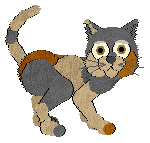 Cat standing | 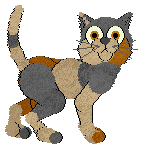 Cat posing |
How to make a cat pose?
Before you begin snapping pictures, turn on "Auto Save Photos" under General Options in the game. If you have PetzA, go to Settings and set the camera picture format to GIF or PNG, your choice. You may also want to use PetzA to set the fatness to around 50 (unless you're going for a skinny or plump kitty), and to verify that your pet is not hungry, tired, or sick. Also make sure that your pet is not wearing any clothes, and that there are no toys laying around as a distraction.
Alright, so let's do it!
1. Pick up your cat. It will spin slowly while you're holding it. If you drop and pick it up again, it will spin in the other direction. Drop it when its head is facing towards the right and when you think it will land with its legs aligned, parallel to the camera. If the angle is slightly off, the pose won't be as good. Sometimes it will take several pickups and drops to get the angle right. You WILL get the hang of it after a short while and KNOW when the angle is just right.
2. When your cat is standing with its legs aligned parallel to your point of view (the camera), start taking pictures right away by pressing the spacebar (I take about one picture every 2 seconds). Doing this will soon trigger the game into making the cat pose.
However, while you're doing this, your cat may decide to move out of its straight angle position, or even start running around crazily. If that happens (and it will, especially for the first pose), pick it up and drop it again at a better angle.
When your cat is done acting up and getting close to posing, it will often enter a recognizable pattern of moves where it might lick its paw, then sit down (continue taking pics and waiting), then get back up (pic, wait), then maybe sit down and get up again... (some breedz go straight into a pose more willingly, like tabbies). You will know when the cat is just about to start posing, because they ALWAYS widen their eyes and do a little hop backward before going through the posing motion! When you see this happen, get your finger ready to take THE picture, but WAIT! Not yet!
3. After the widening eyes and little backward hop signaling your cat is starting to pose, follow the movement of its tail -- don't bother looking at anything else because there's nothing you can do at this point except perfecting the tail position. Catz always go through the same motion, and it always take the same amount of time for the entire pose to take place. You will want to take your picture when the tail is nicely and evenly curved over the cat's back. Not too late, when the tail comes off the perfect curve, and not too early before it's perfectly curved! It lasts only a fraction of a second, so you have to be quick! You WILL eventually know the right timing and be able to anticipate and click at the perfect time, barely looking at all.
 Tip: If your cat tilts its head or closes its eyes in the middle of a posing session, you can briefly click once on its face to snap it out of it without losing your perfect pose angle.
Tip: If your cat tilts its head or closes its eyes in the middle of a posing session, you can briefly click once on its face to snap it out of it without losing your perfect pose angle. Tip: If you are using Petz 3 or 4, you may find it easier to just snap pictures really fast during the entire posing motion, even keeping the spacebar pressed the whole time, and then go find the best one. This is a feature that is not available in Petz 5 though. I usally take just one picture at the exact right time, because I got used to the timing.
Tip: If you are using Petz 3 or 4, you may find it easier to just snap pictures really fast during the entire posing motion, even keeping the spacebar pressed the whole time, and then go find the best one. This is a feature that is not available in Petz 5 though. I usally take just one picture at the exact right time, because I got used to the timing.Breedz that are more difficult or less willing to pose (such as the Orange Shorthair, Alley Cat, Siamese, and Calico to a lesser extent) can be posed by spraying them with the Love Potion. Using this method will give them a very slanted eyelids/worried look on their face (natural Oshies always have slanted eyelids when posing, but the Love Potion intensifies that worried look, with even more slanted eyelids). All the breedz I just mentioned can however learn to pose on their own using the standard method, except (I believe) the Siamese who will only do his laying down Sphinx-like or stretching poses (the one clear indication it has a Siamese personality), and will only standard-pose if using the Love Potion.
Note that after your cat has posed, they will be more willing to pose again than they were the first time. So you shouldn't have too much trouble taking a few more pictures after re-dropping your cat for optimal angle and leg alignment, tail, and general look. I'll explain in more details what to look for below.
Pick a Show Name!
When you have a pose you're happy with, it's time to pick a show name for your pet! Show names can be anything you like! I always found it a lot of fun to come up with a good show name for my petz

You will also need what's called a "prefix" for yourself, one that is not already used by somebody else. A lot of people would use their kennelz/cattery initials as a prefix back in the days (for instance, I use "RKC" for Ratqueen Kennelz & Cattery), but you can simply use your forum name (i.e. I could use "Ratqueen" instead of "RKC", or even just "RQ"). Whatever you want to identify you and you only.
If you show a pet that you have adopted from someone else, or that someone else hexed for you, it is customary to use their own prefix in front of yours, to make it clear to everybody where the pet came from. For instance, my cat Allegra was hexed by Star, and her show name is "Star/RKC's Come Back". If the person didn't specify their show prefix in their adoptions, ask them what they would like used to identify them.
How to judge a show?
No favoritism!
An important part of judging a show is that you must remain completely impartial. You cannot show any favoritism towards people you like, or be harsh towards someone who annoyed you. You cannot favor one breed of cat over another. You cannot favor a cute cat with a bad pose over a less cute one with a perfect pose. You have to look at the quality of the poses entered in your show, and the poses only. In order to do this, you need to have a clear understanding of what is a quality pose and what is not. If you are confronted with several poses that you consider absolutely flawless (and you will), only then is it okay to be influenced by the pet's looks according to your own personal taste. This is the way I judge: pose first, and if there's a tie, looks second. Nothing else.
No editing!
Show pictures should be the exact picture you got when you clicked the in-game camera, converted into a web-friendly format such as .gif or .png. Sherlock Software's free program, PetzA, can be set to automatically take all Petz pictures taken in either of those formats.
A type of editing you should watch for when judging is "flipping". Left-facing poses are generally disallowed. If someone manages to get a perfect pose that is facing left, they might be tempted to flip the picture horizontally to obtain a right-facing pose. Here are examples of a left-facing pose, an originally left-facing pose that was flipped to face right, and a right-facing pose:
Left-facing pose  | Originally left-facing pose, but flipped image 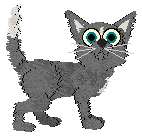 | Right-facing pose  |
As you can see above, the easiest way to tell if you have a flipped image is the back legs. In a right-facing pose, the foot nearest the camera should be in front of the foot furthest from the camera. Flipping images is considered editing, which is not allowed.
If you suspect that an edited picture has been entered in one of your shows, notify a moderator immediately. Editing show pictures is strictly forbidden and can holds serious consequences for the offender.
Take body type & breed into account (if possible)
A good judge will also learn to take into consideration the pet's body type and apparent personality, if at all possible, and not penalize a cat that is in the best possible pose its body shape or personality allows him to achieve. This type of "advanced judging" will come to you naturally with experience.
What is a good cat pose versus a bad pose?
There are two main factors to take into account when judging a standard pose, and a third one that may or may not count depending on the breed's personality. Front legs, tail, and sometimes eyelids. Here is what you are looking for in a good show pose:
Legs:
The front legs must be perfectly aligned. Optimally, you should see only one front leg, with the left front leg completely and perfectly hidden behind the one closest to you, without any pixels showing on either sides. This is usually a deciding factor when comparing several good poses. The ones showing the least bit from the other leg are preferable and should place higher. Note that all of these catz have perfect leg alignment:
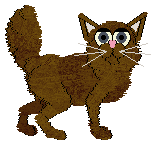 | 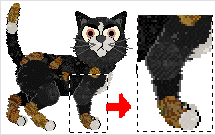 | 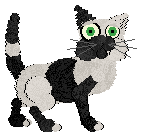 | 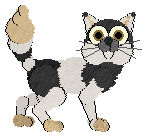 |
Sometimes, with certain colored catz (zoomed in above), it may be hard to tell whether the legs are aligned at a glance because the paws look like they might not be. Usually, the legs are indeed aligned, such as with the hexed cat above.
You may need to zoom in to take a closer look. To do this, you can either save the picture to your hard disk and look at it with the zooming feature of any graphic program, or you can download this handy little screen magnifier, which allows you to zoom in any part of your screen on the fly: ZoomPlus (100% freeware and crap-free, just unzip, no installation required).
Some catz that have larger and longer feet, such as the Calico feet, also often show a bit of the hidden foot despite having a good leg alignment -- this is almost unavoidable for this foot type.
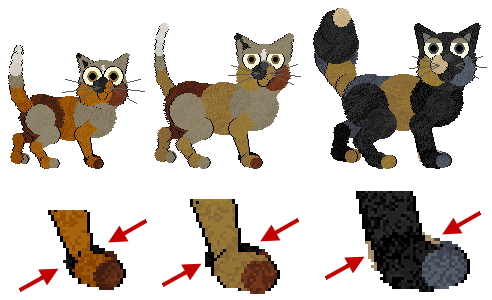
Perfectly aligned legs, showing unavoidable bits of left foot.
The Siamese and Japanese Bobtail breedz (and some of their mixed descendants) have very thin straight down legs, (as opposed to being more or less slanted in other breedz). These frong legs may have a few pixels showing on one side of the leg or the other (it's usually just 1, 2 or 3 pixels off, no more -- if it's more than 3 pixels, then the legs are likely not optimally aligned). This is also often unavoidable and body-type-specific. Using PetzA to set the fatness of the cat to at least 50 or 60 may help diminish that effect slightly, but often not completely.
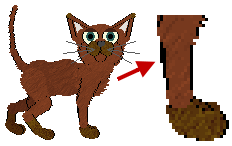 | 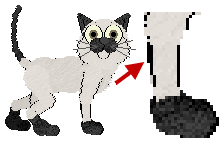 |
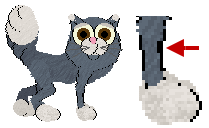 | 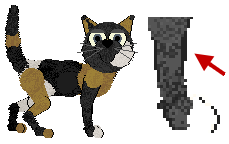 |
Pictured above are four thin-legged mixies (and you can see how their front legs point mostly straight down, not at a slant) showing a few unavoidable pixels on one side of the leg or the other. The two catz on the left only show 2 or 3 pixels, which is totally acceptable for this type of legs, while the two on the right show at least 4 or 5 pixels, which is one or two too many. The two on the left do have optimally-aligned legs -- there is little chance they could achieve a better pose or show any less pixels on the side of their legs. With the two on the right side, though, they could probably have been positioned a tad better to shave off another pixel or two from the other leg. Not a severe fault for any of them though, because of their leg type.
Similarly, as shown in the 3 pictures below, the wide and angled Calico legs may also sometimes show a pixel or two on the left or right side of the leg. This can be seen as a fault, but it isn't a severe one for this type of legs either:
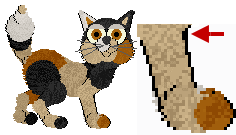 | 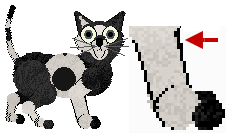 | 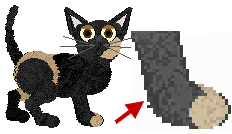 |
 Tip for dark of black fur: you may want to either temporarily brighten your monitor's contrast, or save the picture to your hard disk and brighten it to see the black area more clearly, like we did for two of the pictures above.
Tip for dark of black fur: you may want to either temporarily brighten your monitor's contrast, or save the picture to your hard disk and brighten it to see the black area more clearly, like we did for two of the pictures above.The Persian's front legs have a few particularities, too. They are slanted and wide, similar to the Calicos, only wider and shorter. Another detail that differentiates them from Calico legs is that they have no visible outline above the feet. This make them seem like they could possibly be misaligned, especially because of the way the leg meets the very back of the foot. The Persian's legs can however achieve perfect alignment, a feat that is often difficult for the Calicos.
Here are a few examples of Persian mixies with fluffy and smooth legs:
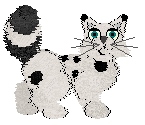 | 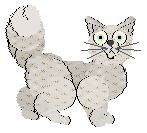 | 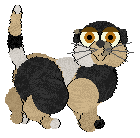 |
All these breed-related quirks and imperfections should not be penalized too heavily, or at all depending on the situation. Only when comparing otherwise equal poses (i.e. from 2 Calico type catz) should you take these differences into account when judging.
Do not be afraid to be picky though. Many shows you run will get lots of good and practically perfect poses, so if you don't get picky, judging will be that much harder.
What about the back legs? Back legs and feet do not matter. If a cat is angled correctly, parallel to the camera so that its front legs are perfectly aligned, then its back legs will be in the only position they can be, and therefore should not be looked at as a jugding factor.
So, to summarize, mostly excellent poses in the batches above. Later on, we'll look at some poses that aren't so good, but for now we want to get an idea of what a good pose is so that we will better understand when we see a bad one. Next, we look at another important feature.
Tail:
Tails can be tricky. Contrary to legs and eyes, which are at least similar between catz, tails can appear widely different depending on the breed, and you will have to take that into consideration when judging. However, the only time you need to look at tails at all is if the cat has a standard, up-tail. Bob-tail and down-tail catz cannot hold their tails any other way, so this should not be taken into account when judging them. With bob-tail and down-tail catz, you only need to consider the front leg, and possibly the eyelids.
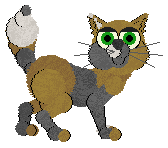 1. Fluffy tail |  2. Poofy tail | 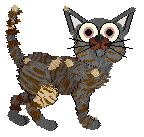 3. Normal tail | 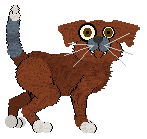 4. Calico tail | 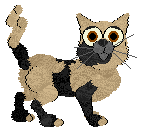 5. Alley tail |
Notice that with all five catz above, the tail is curved up and over the back. These are excellent tails. Straight tails are undesirable, although they may be acceptable if it's not too pronounced, but certainly not exceptional like these. The worst tails are those that are angled or curved away from the body.
The more evenly curved the tail is over the cat's back, the better.
1. Fluffy tail: Because of the fluff, this type of tail appears not to curve quite as far over the back of the cat as the normal tail does. It is however capable of bending slightly towards the back, with a light but noticeable curve. When the fluffy tail is in its optimum position, there's a little ball with a clear outline visible at the top -- the whole thing looks a bit like a soft-serve ice cream cone that's leaning to the right. If this tail is straight, you can count it as a fault.
2. Poofy tail: This tail is larger and wider than the fluffy tail, which makes it appear to bend even less. But if you look closely, just like the fluffy tail, it is capable of a slight bend towards the back, with a light but noticeable curve. Here, too, you can fault it for being straight (but don't mistake the fluff/poofiness for it being straight), because it is indeed capable of a ligth curve.
3. Normal tail: The normal tail is neither very thick nor very thin. It is usually capable of bending over the back of a cat with a nice even curve. Anything less should be counted as a fault for this type of tail.
4. Calico tail: Yes, this fancy mixie that looks more like a weird Alley cat sports a Calico tail! The Calico tail is recognizable by its thickness, which is unlike any other breed's tails. This tail seems more rigid than a normal tail. It typically won't bend as far on the cat's back, and won't curve quite as nicely. Because this is an inherent trait of the Calico tail, it should not be penalized harshly. The cat pictured above actually has an optimally-posed tail for this type of tail.
5. Alley tail: Alleys feature a crooked tail, with more or less breaks in it, that makes them look like they've just been struck by lightning. Their tail remains "straight" in its crookedness, meaning it doesn't really bend or curve. It can however go up and down, so a properly-posed alley tail should point straight up, as close as possible to the back of the cat, as pictured in the example above.
There is an optimal position for each type of tail (shown in the examples above), when it went as far as it can go during the pose sequence, just before it curves back the other way. That's the exact positioning I'm always looking for -- the best it can physically achieve -- and you will learn to recognize it as you pose different catz and see plenty of them in shows.
Eyes & eyelids:
When a cat poses, it will look directly at the camera and hold its head high. There are four types of eye positions, each dictated by the cat's breed personality. We can refer to them as straight eyes, angry eyes, sad eyes, and wide eyes. All of those types of eyes are perfectly acceptable.
The only thing you may have to worry about is not whether the cat has sad or angry eyes, but whether or not the eyelids are even. A cat's eyelids may look uneven when it is posing at an angle that is not perfectly parallel to the camera (but then it would also be visible in its imperfect legs' alignment). It's particularly visible on cats that pose with straight eyes. This is a way to help you decide whether or not you should take uneven eyelids into account when judging.
Here are examples of each of the types of eyes:
The only thing you may have to worry about is not whether the cat has sad or angry eyes, but whether or not the eyelids are even. A cat's eyelids may look uneven when it is posing at an angle that is not perfectly parallel to the camera (but then it would also be visible in its imperfect legs' alignment). It's particularly visible on cats that pose with straight eyes. This is a way to help you decide whether or not you should take uneven eyelids into account when judging.
Here are examples of each of the types of eyes:
 1. Straight Eyes | 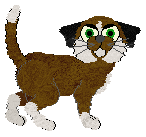 2. Angry Eyes | 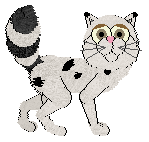 3. Sad Eyes |  4. Wide eyes |
1. Straight Eyes: Note how the eyelids form an even straight line across the eyes. Neither eyelid higher or lower than the other.
Catz with a Russian Blue or Egyptian Mau personality pose with straight eyes.
2. Angry Eyes: Though tilted at an angle that gives the impression of annoyance on the cat's part, the eyelids are still even. Neither eyelid is larger or smaller than the other. They are perfectly aligned.
Catz with a Black & White or Japanese Bobtail personality always pose with frowning, angry-looking eyes.
3. Sad Eyes: The same thing goes for sad eyes. The eyes are tilted as to give the impression of sadness, but they are still aligned and even.
Catz with an Orange Shorthair or Persian personality pose with sad, worried eyes.
4. Wide Eyes: Here the eyelids aren't visible at all, so there is no concern for whether they are even or not.
Catz with a Tabby or Maine Coon personality always pose with wide open eyes.
There is one more type of eyes, or rather eyelids, we need to talk about:
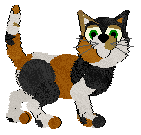 Calico eyelids Slanted and uneven | 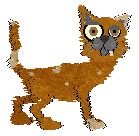 Alley eyelids Straight and uneven | 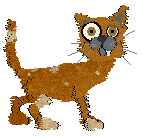 Alley eyelids Slanted and uneven |
5. Naturally uneven eyelids: Calico and Alley personality catz are not only less willing and more difficult to pose than other breedz, but they will also randomly have uneven eyelids while posing -- sometimes it's just a little, and sometimes it's a lot. This is inherent to their breed and should therefore not be faulted unequivocally or heavily, or at all. Only if you must compare two similar poses, one with even and one with uneven eyelids, or one with slightly uneven eyelids and the other with severely uneven eyelids, should you consider placing the one with the most even eyelids higher.
The Calico's eyelids will often be uneven if the cat has a Calico personality, but at least one eyelid will always be slightly slanted. If a cat that looks like a Calico has two straight line eyelids (uneven or not), that's a good indication it probably does not have a Calico personality, and therefore uneven eyelids could be counted as a fault.
The Alley's eyelids can be either straight line or slanted, whether there are even or not, and sometimes even wide eyed, or one of each. If uneven, chances are high it's because of the Alley personality so, in doubt, it shouldn't be counted as a fault.
How to judge hexed breedz/petz with no outlines?
A lot of hexed petz, hexed breedz, as well as more realistic breedz than the petzy kind, will have no outlines around their bodies. With Original Breedz (OBs), there is always a black outline (sometimes colored a different color), which makes it easier to see when the legs are not aligned perfectly. When there is no outline, you might be looking at white on white, or black on black, or the same colors overlapping, making it much harder to discern the legs alignment. Let's take a look and compare:
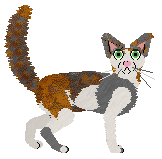 | 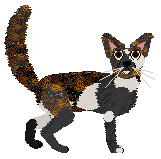 | 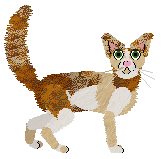 | 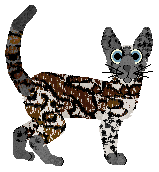 |
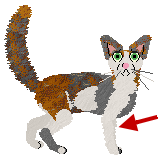 | 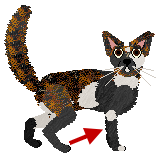 | 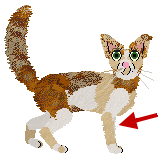 |
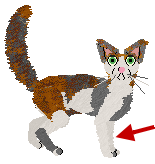 | 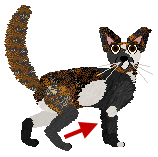 | 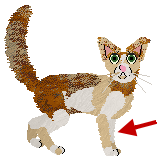 |
From the examples above, you can see that it's a lot more difficult to see when the legs are not aligned when there is no outline, especially if both legs are the same color, and also if the angle is off by only a little bit. The first row has perfect poses, the second row okay poses, and the third row bad poses.
If you loo closely (you may need to zoom in or temporarily adjust the contrast and brightness of your monitor), you will notice that the leg that is supposed to be hidden is generally a slightly darker or different tone than the other one. Another thing to notice, and which helps with determining legs alignment, is that, when the cat is angled with its head away from the camera, the space between its back legs increases. The opposite happens when the cat's head is angled towards the camera, with the space between its back legs decreasing.
What do bad poses look like?
In most of the previous examples, the poses we saw were practically perfect, or at least good. Legs and tails all fit the standard pose requirements beautifully, eyelids were fine for each particular breed personalities. Now we will take a look at some poses that aren't as good as these. I dare say, these poses are just plain bad. Each of the following catz has some problem with their pose. Take a look and see if you can tell for yourself where the problem lies before you continue reading.
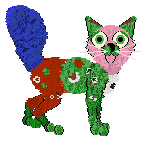 Pose 1 | 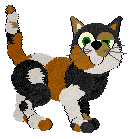 Pose 2 | 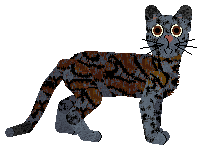 Pose 3 | 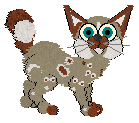 Pose 4 |
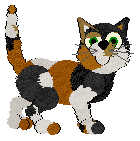 Pose 5 |  Pose 6 | 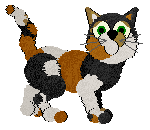 Pose 7 | 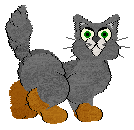 Pose 8 |
Did you see the problems? We'll go over them one by one. Let's start with Pose 1.
 Pose 1 |
First of all, the legs are not aligned. This means the cat was standing at an angle to the camera, if ever so slight. Also, the tail is curved backward, away from the body. The eyes, however, are good. Sad, but even.
 Pose 2 |
Pose 2 is unfortunately bad all around. First, we notice that the legs are severely misaligned. Next, the tail is angled away from the body. Lastly, the eyes are very uneven -- however, this is a trait inherent to the Calico and Alley Cat's personalities, and should not be penalized severely for those breedz (note that mixies may look like one breed but have the personality of another breed). If you have two similarly-posed Calico/Alley type catz in your show and only one has uneven eyelids, it would be right to place the one with the even eyelids above the one with uneven eyelids. But all in all, this pose would not even make an Honorable Mention, as none of the features in this show pose are even close to correct.
 Pose 3 |
With this pose there is only one real problem. The eyes are even and the cat has a down tail, so those features are just fine. However, the legs are not aligned. You may have to look closely due to the fact that this cat has not outline and thus the color of the legs causes them to blend together, but upon closer inspection, the legs are indeed unaligned.
 Pose 4 |
Ooh, pretty kitty-kitty, all hexed and stuff! But is this pose any good? Nope. It presents two major problems: the front legs are very misaligned, and the fluffy tail is bent backward, away from the body.
 Pose 5 |
This pose has only one problem. The tail is not perfectly curved, almost straight. It is however acceptable for a Calico, because their tail typically doesn't bend as far, and doesn't curve as nicely as other tails. This particular kitty could have achieved a slightly better curve though, even for a Calico tail (see other exemples of good poses with Calico tails earlier). For another type of cat tail, this would not be desirable, although not a severe fault. The legs are nicely aligned. The eyes are uneven, yes but, again, this is a trait of the Calico personality. Some people penalize for it, but we think it is unfair and should be mostly ignored when it's part of a breed's natural behavior. As said above for Pose number 2, if you have two similarly-posed Calico or Alley type catz in your show and only one has uneven eyelids, it would be right to place the one with the even eyelids above the uneven eyelids.
 Pose 6 |
Looks like a great pose, yes? Eyes are wide, front legs are aligned, tail is curved toward the body... One problem, though. If you haven't found the problem with this pose, take a closer look at the back legs. This picture has been flipped! The leg nearest the camera is behind the one furthest away from the camera. This means that the picture was originally a left-facing pose and the owner used a picture editing software to flip the picture. This image should be disqualified and reported to a moderator.
 Pose 7 |
Here we have two problems. One is obvious, as the tail is overtly angled away from the body. The second problem is that the front legs are not aligned.
 Pose 8 |
Could you find anything wrong with this one? Uh oh... looks like we tried to trick you! This kitty may not be a looker, but it is actually perfectly posed, to the best of its chubby little body's ability! This one and pose number 5 above are the only ones out of the batch of 8 that should even place in a show (although number 3 is not too horrendous, if that's all you have to work with).
Give it a try! (below)
Now that you've seen some examples of excellent, okay, and bad poses, you will hopefully feel more confident judging your first show. Practice makes perfect though, so you can test your newly-acquired judging skills by trying to spot the best and worst poses out each groups posted below. This is just for your own personal testing. The correct answers are posted at the very bottom of the post (in white text, so you will have to highlight it to see it).
When you're done here, why not come visit the Show Arena and enter a show? Don't be intimidated. Give it a try, it's fun!

 |  |  |  |  |  |  |  |  |  |


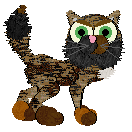
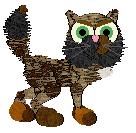
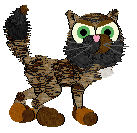
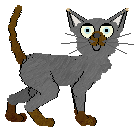
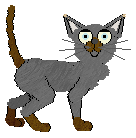
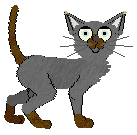
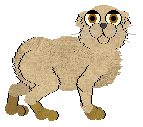
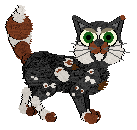
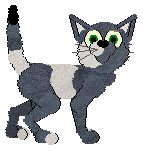
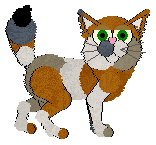
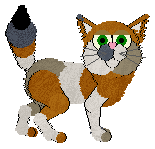
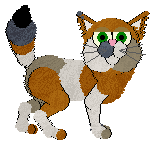
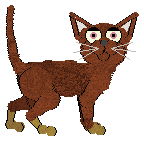
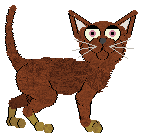
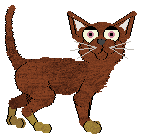
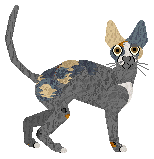
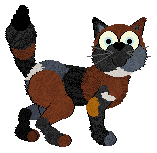
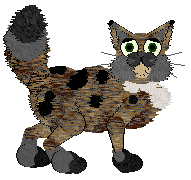
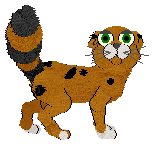
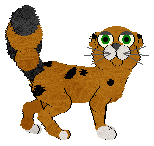
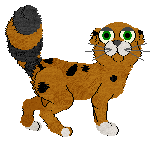
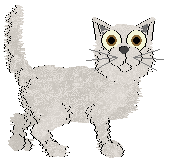
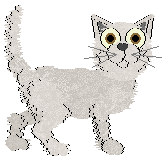
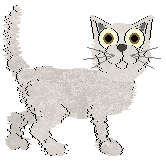
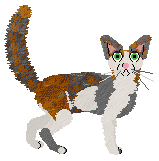
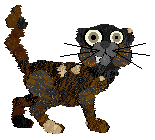
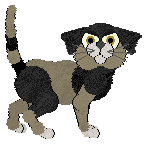
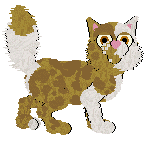
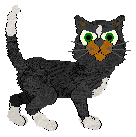
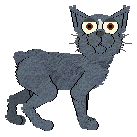
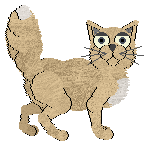
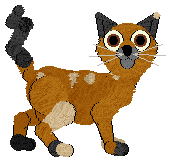
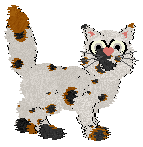
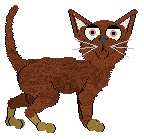
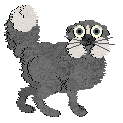
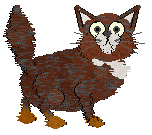
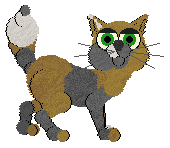
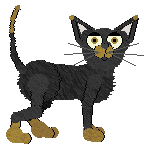
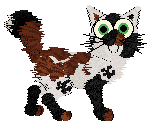
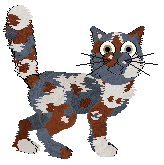
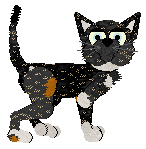
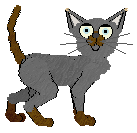
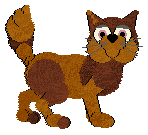
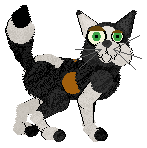
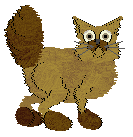
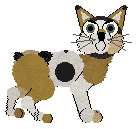
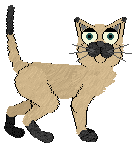
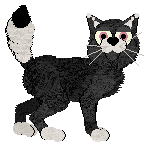
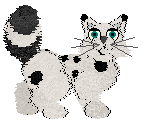
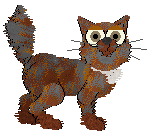
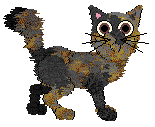
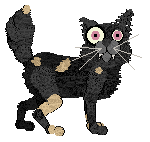
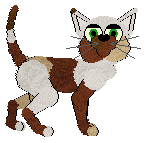
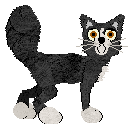
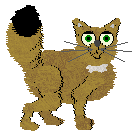
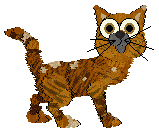
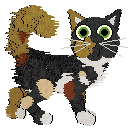
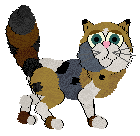
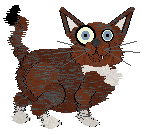
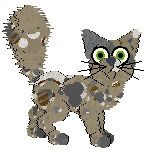
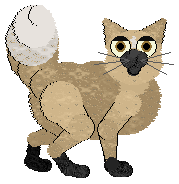
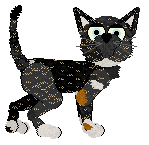
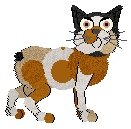


![[thumbup]](http://storage2.proboards.com/216663/images/TOVmNkVKkylWkNpJYDOX.gif) And don't worry too much, in the end it's just for fun!
And don't worry too much, in the end it's just for fun! I appreciate you taking the time to explain it all to me. I'm looking forward to running a show too!
I appreciate you taking the time to explain it all to me. I'm looking forward to running a show too! 







 I've been a slacker. *blush*
I've been a slacker. *blush*